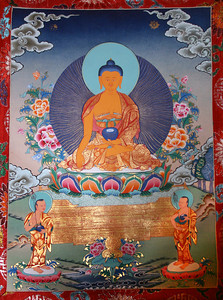From teachings given by Jetsunma Ahkon Lhamo
What is meditation?
Meditation is the natural state of mind when it is relaxed, stable, and open. When our mind is calm and settled, there is a spaciousness that allows time between action and reaction. The trouble is that the mind more frequently runs wild like a monkey. That is what happens when the mind is too agitated, wound up, or out of control. The mind controls you rather than the other way around.
The point of meditation is to create space in your mind. The mind is like a muscle. In the same way that you do physical fitness training to keep your body strong, the mind needs to be trained to be calm and relaxed, yet also alert and wakeful. For Buddhists, meditation is the means by which to experience wisdom directly.
Meditation Techniques
Meditation can be practiced by anyone, regardless of religious tradition.
The following are some simple meditation techniques as explained by Jetsunma Ahkon Lhamo:
Posture
While there are more elaborate explanations for how to hold the body, in general it is beneficial to sit comfortably with one’s back straight. A firm cushion is useful to lift the body some. In our tradition, we meditate with our eyes slightly open.
Watching the Breath
A very simple, yet powerful, technique is to watch the breath. You can take very uniform relaxing breaths. Four beats in, hold one, four beats out. Let your mind rest on the rhythm and feel of your own breath. For a person whose mind is too active and angry, it is very restful, very peaceful to do this.
Single-pointed concentration
Single-pointed concentration is a beautiful practice. Take an image of the Buddha, or flower, or candle, and concentrate on that. Let everything else go completely. Sit and watch the image. You are filled with the image and you take note of the image, looking at the finest parts of it. If you use a candle, focus on the nature of that flame. Simply see what it is. See only that. Let the mind rest on the image or candle or flower. When the “I left the iron on” thoughts come into your mind, you dismiss them and go back to the concentration. If you have trouble dismissing thoughts, you can use a visualization of cutting them with scissors, and throwing them away. You always return to your single-pointed concentration. Come back to rest. If you have thoughts, no matter what they are, just laugh at yourself, drop them and come back to the concentration. It is extremely relaxing and healing to let the mind rest. The resting will get longer and longer as you practice. Once you learn to apply meditation or concentration, the mind has more control, more “muscle.”
Jetsunma gives the background on her experience with meditation in Stablizing the Mind, a collection of teachings and practical instruction.












Very nice website and post on How to Meditate. I look forward to learning more about Jetsunma. My Shambhala Buddhist lineage, http://www.shambhala.org/, also reveres her teacher’s Penor & Khentse Rinpoche.
Bruce
Hi Bruce. We have lots of good friends in Shambhala. And love the Shambhala website. It is gorgeous. Thanks for the comment.